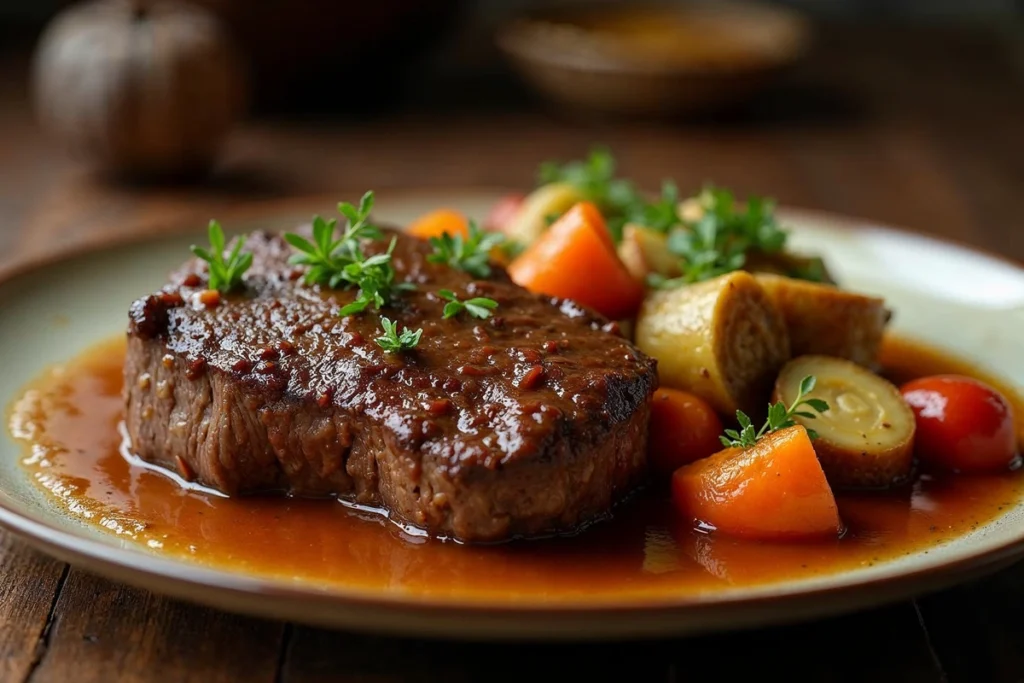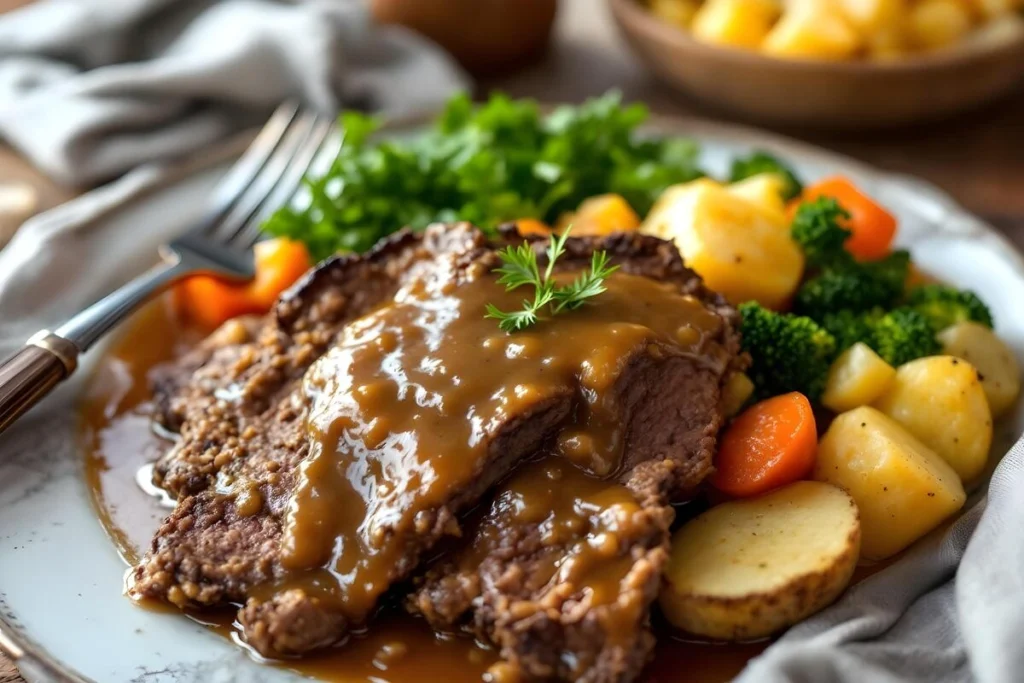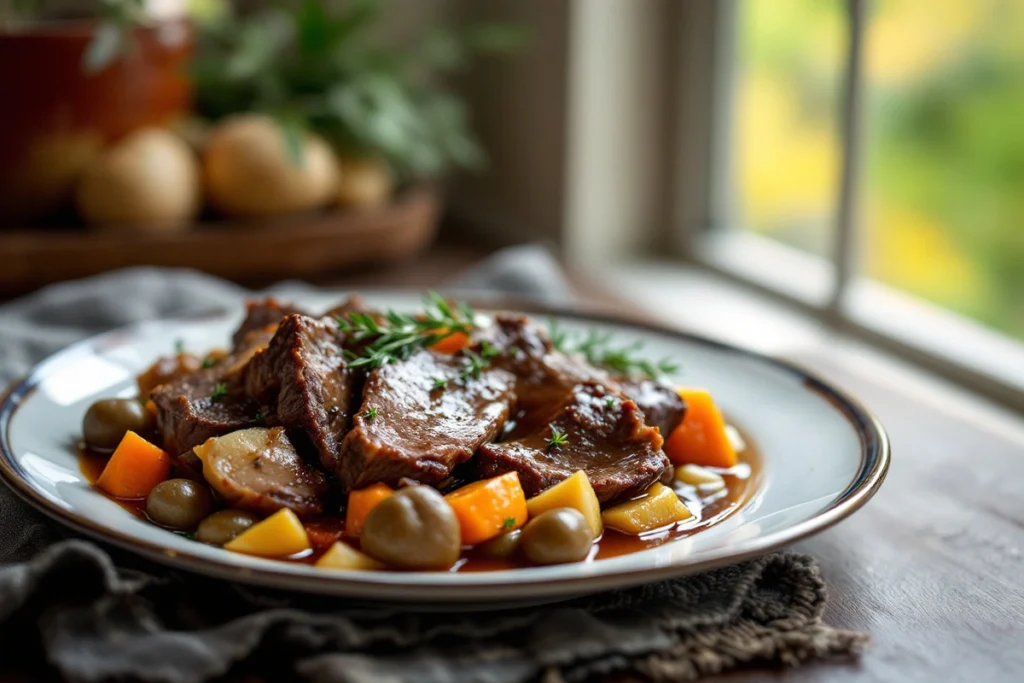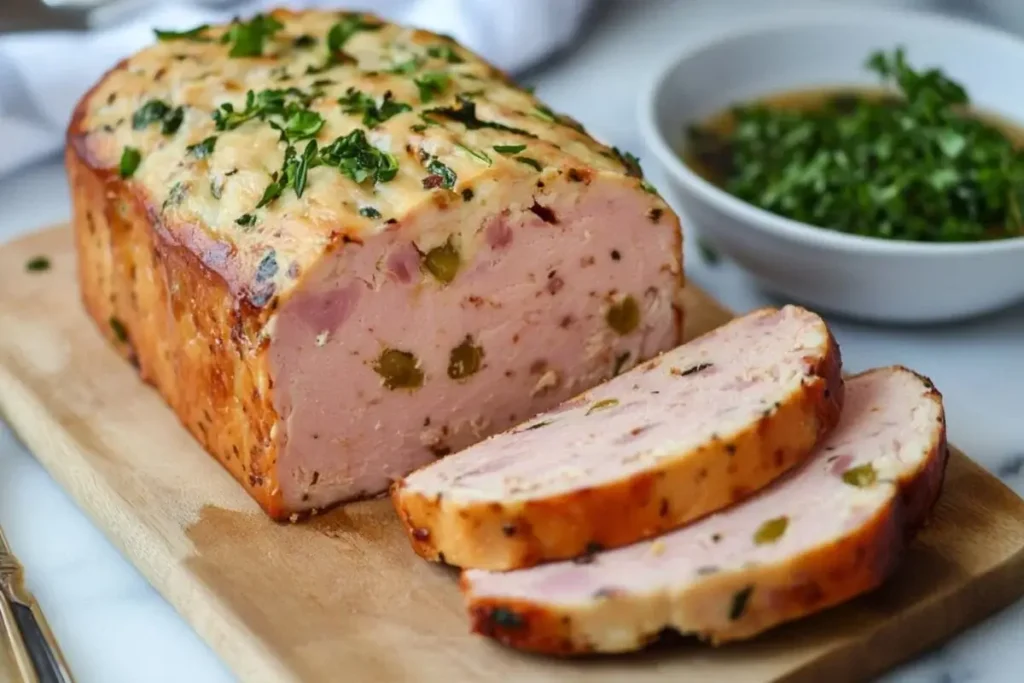
Introduction
What is Beef Pot Roast?
Beef Pot Roast is a slow-cooked dish that transforms tough cuts of beef into tender, flavorful meals by braising them in a flavorful liquid. Often accompanied by hearty vegetables and aromatic herbs, pot roast is a one-pot meal that is both satisfying and versatile.
The History and Tradition of Pot Roast
The origins of pot roast can be traced back to European cooking traditions, where slow-cooking tougher cuts of meat was a common method to make them tender and delicious. Immigrants brought these techniques to America, blending them with local ingredients and flavors. Over time, pot roast became a beloved dish in households across the country, symbolizing warmth, comfort, and family gatherings.
Why Beef Pot Roast is a Classic Comfort Food
Pot roast is celebrated for its rich flavors, tender texture, and heartwarming appeal. It’s a dish that requires minimal effort but delivers maximum comfort, making it a favorite for Sunday dinners and special occasions. The combination of slow-cooked beef, vegetables, and herbs creates a hearty, nourishing meal that brings people together.
Key Ingredients for Beef Pot Roast
Selecting the Best Cut of Beef: Chuck, Brisket, or Round
The key to a great pot roast is choosing the right cut of beef:
- Chuck Roast: Known for its marbling, chuck roast becomes incredibly tender and flavorful when slow-cooked.
- Brisket: Slightly leaner than chuck but equally delicious, brisket works well for pot roast with a rich, hearty flavor.
- Round Roast: A leaner option that benefits from slow braising to achieve tenderness.
Vegetables That Complement Pot Roast: Carrots, Potatoes, and Celery
Hearty root vegetables are traditional additions to pot roast, as they absorb the flavors of the braising liquid:
- Carrots: Add a touch of sweetness and color to the dish.
- Potatoes: Provide a starchy, filling component, often served whole or cut into chunks.
- Celery: Contributes subtle flavor and texture to the braise.
Other options like parsnips, turnips, or mushrooms can also be included for variety.
Aromatics and Herbs: Garlic, Rosemary, and Thyme
Aromatics and herbs elevate the flavor of pot roast:
- Garlic: Adds depth and richness.
- Rosemary and Thyme: Infuse the dish with earthy, herbal notes.
- Bay Leaves and Parsley: Optional but excellent for enhancing complexity.
Broth, Wine, and Other Liquids for Braising
The liquid used for braising is crucial to creating a flavorful pot roast:
- Beef Broth: A classic base that intensifies the beefy flavor.
- Red Wine: Adds depth and a touch of acidity, complementing the richness of the beef.
- Tomato Sauce or Paste: Provides a subtle tang and thickens the braising liquid.
- Water with Bouillon: A simple alternative for creating a flavorful base.
Tools and Equipment Needed
Dutch Oven vs. Slow Cooker: Which is Best for Pot Roast?
- Dutch Oven: Ideal for those who prefer stovetop-to-oven cooking. It provides excellent heat distribution and allows for browning the beef directly in the same pot before braising.
- Slow Cooker: Perfect for set-it-and-forget-it convenience. While it doesn’t allow for direct searing, you can brown the beef in a skillet beforehand for added flavor. Both options yield tender and flavorful pot roast, depending on your cooking style.
Essential Kitchen Tools: Knives, Cutting Boards, and Thermometers
- Sharp Knife and Cutting Board: Essential for trimming and cutting the beef and vegetables uniformly.
- Tongs: Handy for turning the beef during searing.
- Meat Thermometer: Helps ensure the roast reaches an internal temperature of 190-200°F (88-93°C) for optimal tenderness.
Tips for Prepping Ingredients and Cleanup
- Pre-Cut Vegetables: Chop vegetables into large, uniform pieces to prevent them from becoming mushy during long cooking times.
- Organize Ingredients: Arrange all ingredients within reach to streamline assembly.
- Easy Cleanup: Line your cutting board with parchment paper or prep in stages to minimize mess.
Step-by-Step Guide to Cooking Beef Pot Roast
Preparing the Beef: Seasoning and Searing
- Trim and Season: Trim excess fat from the beef, pat it dry, and season generously with salt, pepper, and optional spices like paprika or garlic powder.
- Sear for Flavor: Heat oil in your Dutch oven or skillet over medium-high heat. Sear the beef on all sides until a deep, golden crust forms. This step locks in juices and enhances flavor.
Assembling the Roast: Layering Vegetables and Beef
- Layer Vegetables First: Place hearty vegetables like carrots, potatoes, and celery at the bottom of your pot or slow cooker. This forms a flavorful base and prevents the beef from sticking.
- Add the Beef: Nestle the seared beef on top of the vegetables.
- Pour in the Liquid: Add your chosen braising liquid—broth, wine, or a combination. Ensure the liquid covers about two-thirds of the beef.
Braising the Roast: Low and Slow Cooking for Tenderness
- Cooking in a Dutch Oven: Cover and bake in a preheated oven at 300°F (150°C) for 3-4 hours.
- Using a Slow Cooker: Cook on low for 6-8 hours or high for 4-5 hours. The long, slow cooking process breaks down the tough fibers, resulting in tender beef.
Testing for Doneness: When the Beef is Perfectly Cooked
- Check Tenderness: Insert a fork into the beef—if it pulls apart easily, the roast is done.
- Temperature Guide: The internal temperature should reach 190-200°F (88-93°C) for fall-apart texture.
- Rest the Roast: Allow the pot roast to rest for 10-15 minutes before serving to let the juices redistribute.

Cooking Methods for Beef Pot Roast
Traditional Oven-Braised Pot Roast
Oven braising is a classic method for making pot roast. The beef is seared, layered with vegetables, and slow-cooked in a Dutch oven or covered baking dish at 300°F (150°C) for 3-4 hours. This method develops deep, rich flavors and ensures tender, fall-apart beef.
Slow Cooker Pot Roast for Busy Days
A slow cooker offers convenience and consistency for pot roast. After searing the beef on a skillet, layer it with vegetables and braising liquid in the slow cooker. Cook on low for 6-8 hours or high for 4-5 hours. It’s a hands-off method perfect for busy schedules.
Instant Pot Pot Roast: A Quick and Easy Alternative
The Instant Pot is ideal for creating pot roast in a fraction of the time. Sear the beef using the sauté function, then add vegetables and liquid. Pressure cook for about 60-80 minutes, depending on the size of the roast, followed by a natural release for ultra-tender results.
Stovetop Pot Roast: Tips for Even Cooking
For stovetop pot roast, use a heavy-bottomed pot or Dutch oven. Sear the beef, add vegetables and liquid, and simmer on low heat for 3-4 hours. Stir occasionally to prevent sticking, and ensure the heat remains consistent for even cooking.
Variations of Beef Pot Roast
Classic American-Style Pot Roast
The quintessential pot roast features beef, potatoes, carrots, and celery, braised in a simple beef broth with onions and garlic. This hearty, comforting version is a family favorite that highlights classic flavors.
French-Inspired Pot Roast with Red Wine (Boeuf à la Bourguignonne)
This French twist on pot roast incorporates red wine, pearl onions, mushrooms, and bacon. Braised in a rich wine-based sauce, this elegant dish is perfect for special occasions.
Italian Pot Roast (Stracotto) with Tomatoes and Herbs
Stracotto is an Italian version of pot roast, slow-cooked with tomatoes, red wine, garlic, rosemary, and bay leaves. The result is a tender roast infused with Mediterranean flavors, often served with polenta or pasta.
Spicy Pot Roast with Chipotle Peppers
For a bold and smoky variation, add chipotle peppers in adobo sauce to the braising liquid. This spicy pot roast pairs well with roasted vegetables or cornbread, offering a flavorful twist on the classic.
Sides and Sauces to Serve with Beef Pot Roast
Mashed Potatoes and Gravy
Creamy mashed potatoes are the perfect companion to pot roast. Their smooth texture complements the tender beef, and they soak up the flavorful gravy made from the braising liquid, creating a comforting and satisfying pairing.
Crusty Bread for Sopping Up Juices
A loaf of crusty bread, such as a baguette or sourdough, is ideal for dipping into the rich juices and sauce from the pot roast. This simple side adds a hearty, rustic element to the meal.
Fresh Salads or Roasted Vegetables
Lighten up the meal with a fresh green salad or roasted seasonal vegetables. Salads with vinaigrette dressing provide a refreshing contrast, while roasted vegetables like Brussels sprouts, parsnips, or asparagus add depth and variety.
Red Wine Jus or Mushroom Sauce
Elevate your pot roast with a gourmet sauce:
- Red Wine Jus: Reduce the braising liquid with red wine and butter for a rich, velvety sauce.
- Mushroom Sauce: Sauté mushrooms and stir them into a portion of the braising liquid for an earthy, flavorful addition.
Tips for Perfecting Beef Pot Roast Every Time
Achieving a Tender, Fall-Apart Texture
- Choose the Right Cut: Opt for well-marbled cuts like chuck roast or brisket, which become tender when slow-cooked.
- Low and Slow Cooking: Cook the pot roast at a low temperature over several hours to break down tough connective tissue.
- Rest the Meat: Allow the roast to rest for 10-15 minutes after cooking to redistribute juices and maintain tenderness.
Balancing Flavors in the Braising Liquid
- Layer Seasonings: Use a mix of aromatics, herbs, and spices to create depth. Common choices include garlic, rosemary, thyme, and bay leaves.
- Enhance with Acidity: Add a splash of red wine, vinegar, or tomatoes to balance the richness of the broth.
- Don’t Over-Salt: Season gradually and taste as you go to avoid overpowering the dish.
Avoiding Common Mistakes
- Skipping the Sear: Always sear the beef before braising to lock in juices and enhance flavor.
- Overcooking Vegetables: Add root vegetables at the start and delicate ones like mushrooms or zucchini later to prevent them from becoming mushy.
- Using Too Little Liquid: Ensure the liquid covers at least two-thirds of the beef to keep it moist throughout cooking.
Enhancing Presentation for a Beautiful Serving
- Slice Carefully: Slice the beef against the grain for the most tender pieces.
- Plate Thoughtfully: Arrange the beef on a serving platter, surround it with vegetables, and drizzle with sauce for an inviting presentation.
- Garnish: Add fresh herbs like parsley or thyme sprigs for a pop of color and a touch of elegance.
Beef Pot Roast for Special Occasions
Pot Roast as a Holiday Main Dish
Beef Pot Roast makes a stunning centerpiece for holiday meals. Its hearty flavors and tender texture appeal to guests of all ages, and it pairs well with festive sides like roasted root vegetables, mashed potatoes, or cranberry relish. For an elevated touch, use premium cuts like brisket and enrich the braising liquid with red wine or port.
Preparing Pot Roast for Large Gatherings
For larger groups, consider cooking multiple pot roasts in separate pots or using a slow cooker to manage portions easily. Pre-chop vegetables and assemble the roasts the night before to save time. Serve family-style on a large platter with fresh herbs for an impressive presentation.
Creating Mini Pot Roasts for Individual Servings
For intimate or formal dinners, create individual portions of pot roast using smaller cuts of beef like short ribs or petite sirloin. Place each mini roast in its own ramekin or cocotte, layered with vegetables and braising liquid. Guests will enjoy the personalized touch and beautifully plated servings.
Storing and Reheating Beef Pot Roast
Proper Storage Techniques
- Cool Before Storing: Allow the pot roast to cool to room temperature before transferring it to an airtight container.
- Separate Components: Store the beef, vegetables, and sauce separately if possible to preserve texture.
- Refrigeration: Keep in the refrigerator for up to 4 days. For longer storage, freeze in portions for up to 3 months.
Reheating Without Losing Moisture
- Oven Method: Place the pot roast in a covered dish with some sauce or broth and reheat at 325°F (160°C) for 20-30 minutes.
- Stovetop Method: Simmer gently in its sauce over low heat, stirring occasionally.
- Microwave Option: Use a microwave-safe dish, cover loosely, and heat in short intervals to prevent drying out.
Creative Ways to Use Leftovers in New Recipes
- Pot Roast Sandwiches: Shred the beef and serve on crusty bread with horseradish mayo or barbecue sauce.
- Pot Roast Hash: Dice leftover beef and vegetables, then sauté with potatoes and onions for a hearty breakfast dish.
- Pot Roast Soup: Use the beef and braising liquid as a base for a comforting soup by adding additional vegetables and noodles.

Healthier Alternatives and Modifications
Using Leaner Cuts of Beef
For a healthier pot roast, opt for leaner cuts like top round or eye of round. While these cuts have less fat, proper marination and slow cooking ensure they remain tender and flavorful. Trimming visible fat from the beef before cooking can further reduce calorie content.
Adding More Vegetables for a Balanced Meal
Incorporate a wider variety of vegetables like parsnips, turnips, sweet potatoes, and zucchini to add nutrients, color, and flavor. Vegetables not only make the dish more balanced but also soak up the savory flavors of the braising liquid, enhancing the overall meal.
Low-Sodium and Gluten-Free Pot Roast Options
- Low-Sodium: Use low-sodium broth and limit added salt. Enhance flavor with herbs, spices, and aromatics instead.
- Gluten-Free: Ensure the broth and any thickening agents used in the sauce are gluten-free. Cornstarch or arrowroot powder can replace flour as a thickener.
Popular Recipes and Regional Variations of Pot Roast
New England Pot Roast with Root Vegetables
A traditional New England Pot Roast highlights the use of root vegetables like carrots, potatoes, parsnips, and turnips. The beef is braised in a savory broth infused with bay leaves, onions, and garlic. Serve with warm rolls or biscuits for a comforting, rustic meal.
Southern Pot Roast with Cornbread and Collard Greens
Southern-style pot roast features bold flavors with spices like paprika and cayenne. It’s often served alongside cornbread and collard greens, creating a hearty, flavorful dish that embodies Southern hospitality. Add a splash of hot sauce or Worcestershire for an extra kick.
International Takes on Pot Roast
- French (Boeuf à la Mode): A sophisticated pot roast with red wine, carrots, and onions, seasoned with bouquet garni for a refined flavor.
- Italian (Stracotto): Cooked with tomatoes, garlic, and rosemary, often served over polenta or pasta for a Mediterranean twist.
- Mexican-Inspired Pot Roast: Features chipotle peppers, cumin, and oregano, served with tortillas or over rice for a spicy, vibrant meal.
FAQs About Beef Pot Roast
What kind of meat is beef pot roast?
Beef pot roast is typically made with tougher, well-marbled cuts of beef that become tender when slow-cooked. Common choices include chuck roast, brisket, and round roast. These cuts are ideal for braising due to their ability to absorb flavor and break down into a juicy, tender texture.
What cooking method is best for pot roast?
The best cooking method depends on your preferences:
- Oven Braising: Offers rich, caramelized flavors and even cooking.
- Slow Cooker: Convenient and hands-off, perfect for busy days.
- Instant Pot: Great for quick preparation with tender results.
Each method ensures a flavorful pot roast when done correctly.
What is a pot roast vs. beef stew?
- Pot Roast: Features a large piece of beef cooked with vegetables and braising liquid, served sliced or shredded.
- Beef Stew: Uses smaller chunks of beef, cooked with vegetables and a thicker broth for a hearty soup-like consistency.
Does pot roast get more tender the longer you cook it?
Yes, but only up to a point. Slow cooking breaks down connective tissues, making the beef tender. However, overcooking can dry out the meat and cause the vegetables to become mushy. Aim for 3-4 hours in the oven or 6-8 hours in a slow cooker for best results.
What is the Best Cut of Beef for Pot Roast?
The best cuts include chuck roast, brisket, and round roast. Chuck roast is the most popular due to its rich marbling and flavor, while brisket offers a leaner alternative with a hearty texture.
Can You Make Pot Roast Ahead of Time?
Yes, pot roast can be made ahead. Cook the roast, let it cool, and store it in an airtight container in the refrigerator. Reheat gently in its sauce to retain moisture. It often tastes better the next day as the flavors continue to meld.
How Long Should You Cook Pot Roast for Optimal Tenderness?
- Oven Braising: 3-4 hours at 300°F (150°C).
- Slow Cooker: 6-8 hours on low or 4-5 hours on high.
- Instant Pot: 60-80 minutes on high pressure, followed by natural release.
Cooking times may vary based on the size and cut of the beef.
Can You Cook Pot Roast Without a Dutch Oven?
Yes, alternative methods include:
- Slow Cooker: A reliable option for hands-off cooking.
- Covered Baking Dish: Works well for oven braising.
- Instant Pot or Pressure Cooker: Ideal for quicker preparation.
What is the Difference Between Pot Roast and Braised Beef?
- Pot Roast: Refers specifically to a large cut of beef braised with vegetables in a flavorful liquid.
- Braised Beef: A broader term for any beef cooked in liquid, which may or may not include vegetables.
How Do You Thicken the Sauce or Gravy for Pot Roast?
- Flour or Cornstarch Slurry: Mix equal parts flour or cornstarch with water and whisk into the braising liquid.
- Reduction Method: Simmer the liquid uncovered until it thickens naturally.
- Butter and Flour Paste: Combine softened butter with flour and stir into the liquid for a smooth, rich gravy.
Beef Pot Roast is the epitome of comfort food, bringing together tender beef, hearty vegetables, and flavorful braising liquids for a meal that warms both the body and soul. Whether you prefer the traditional New England style or international variations like Italian Stracotto, pot roast is a dish that adapts to any occasion. To further enhance your beef repertoire, check out The Ultimate Guide to Beef Wellington or explore savory delights with Beef Kebabs. Visit OrgRecipes for more culinary inspiration and recipes!
Conclusion
Why Beef Pot Roast is the Ultimate Comfort Dish
Beef Pot Roast stands as a timeless classic that embodies warmth, nourishment, and home-cooked comfort. Its tender beef, hearty vegetables, and rich flavors come together to create a dish that satisfies both the palate and the soul. Whether it’s served as a centerpiece for a special occasion or a simple family dinner, pot roast brings people together with its familiar and heartwarming appeal. The versatility of cooking methods, ingredients, and serving styles ensures that this dish remains a staple in kitchens around the world.
Encouragement to Experiment and Personalize Your Recipe
One of the greatest aspects of Beef Pot Roast is its adaptability. Don’t hesitate to make the recipe your own—experiment with different cuts of beef, incorporate a variety of vegetables, and try bold flavors in your braising liquid, like red wine or chipotle peppers. Whether you stick to traditional techniques or explore international variations, your unique twist will make the dish truly special.
Viral Tuna Salad: 5 Bold Reasons Matthew McConaughey’s Recipe Wins
Healthy Homemade Chicken Mortadella
Chicken Mortadella changed my deli game forever. I used to stare at processed meat…
The BEST Taco Pasta
When I’m short on time and need to get a satisfying dinner on…
Classic German Kartoffelpuffer Recipe (Authentic, Crispy & Easy to Make)
Easy Butter Pecan Cookies Recipe
There’s something undeniably comforting about the scent of buttery, nutty cookies wafting from…
Perfect Strawberry Cheesecake Recipe
If there’s one dessert that’s guaranteed to silence a lively room, it’s this…







1 thought on “Beef Pot Roast”